Preprint
Article
Achievement of Food Waste Recycling Law in Japan With Reference to SDG12.3
Altmetrics
Downloads
177
Views
91
Comments
0
A peer-reviewed article of this preprint also exists.
This version is not peer-reviewed
Submitted:
03 December 2023
Posted:
04 December 2023
You are already at the latest version
Alerts
Abstract
SDG target 12.3 calls for halving food waste at retail, food service, and household by 2030. The food waste index for this purpose includes parts attached to food that are usually removed intentionally ("unavoidable food waste") and allows counting the conversion to animal feed and utilisation as biomaterial as means of reduction. In Japan, the "Food Waste Recycling Law" which has been in effect since 2001, promotes the recycling of food waste generated from businesses, designating feed conversion as top priority. On the other hand, based on the more recent "Food Loss Reduction Promotion Act" of 2019, the government is currently promoting the reduction of avoidable food waste, as to meet the SDG target. Based on statistical sources and interviews with Ministry officers, this paper explains the history and achievements of Japan's 23-year policy based on the Food Recycling Law, as well as the tension between the two legislations.
Keywords:
Subject: Environmental and Earth Sciences - Waste Management and Disposal
1. Introduction
1.1. Background: Targets and Policies for Food Waste Reduction in Japan
Adopted by the United Nations in 2015, the Sustainable Development Goals ("SDGs") identify food loss and waste as a key challenge for achieving sustainable consumption, and Target 3 of Goal 12 ("SDG 12.3") states "By 2030, halve global food waste per capita at the retailer and consumer level, and reduce food losses along the production and supply chain, including post-harvest losses" [1].
In Japan, it is understood that this applies to edible or avoidable food waste, that is defined as "food that could have been eaten (but is discarded)," or "food or portions of food that are (physically) edible" [2]. The UK Waste and Resources Action Plan (WRAP) named this as "avoidable food waste" [3]. The Japanese term for this is "食品ロスShokuhin Rosu", which could be literally translated as "food loss". To avoid terminological confusion, in this paper, "avoidable food waste" will be used in place of the Japanese "Shokuhin Rosu", except in the name of the law "Food Loss Reduction Promotion Act" (Shokuhin Rosu Sakugen Suishin Hoh), which actually promotes the reduction of avoidable food waste [2].
We prefer to use "avoidable" rather than "edible" in general context. The term "edible food waste" has a strong connotation of being physically edible (including parts that are physically edible but intentionally removed, or parts that are considered generally inedible, although they could be eaten depending on the person, condition, or on the way they were prepared), while "avoidable" does not ask for a change in food customs, or making a special effort to making the part ingestible. The detailed definition and classification of "edible" and "avoidable" are not discussed in this paper. Please refer to Okayama et al (2021)[4], where the authors conducted another study on the classification of "avoidable food waste" to be reduced under SDG 12.3.
The Food Loss Reduction Promotion Act was enacted as Act no. 19 of 2019 [2]. Since Japan imports a large amount of food and is dependent on imports for much of its food, the Act states that reducing avoidable food waste is an issue that should be taken seriously, and that it is important to create and establish an awareness of not wasting food. The Act also states that it is important to establish an awareness of the importance of not wasting food. It also encourages the public to utilize "food that can still be eaten" as much as possible as food, including measures to providing it to those who do not have sufficient access to necessary food due to poverty, disasters, etc. In other words, the Food Loss Reduction Promotion Act aims to Reduce or Reuse avoidable food waste at the consumption level, rather than to Recycle.
On the other hand, in December 2019, when the SDG 12.3 indicators were upgraded to Tier II (indicators with clear concepts, methods and criteria, but not yet regularly published data) [5], it was stated that "food waste" to be reduced in the target includes inedible as well as edible parts, but a separate reporting of edible and inedible parts is encouraged and recommended. In addition, conversion into feed and material recycling, excluding composting, was considered as a reduction of food waste [6].
This approach is similar to the scheme of Japan's Food Waste Recycling Law, which will be described later. Nevertheless, according to the Voluntary National Review (VNR) report of 2021 [7], which is a report on the progress of the SDGs by each country, Japan focuses only on the evaluation of the reduction of waste of edible parts (reduction of generation) for SDG 12.3 [8]. Figure 1 shows the targets and measures for reduction of food waste and related laws and regulations in Japan.
Back in 2000, "The Law for Promotion of Recycling and Related Activities for the Treatment of Cyclical Food Resources" (Act No. 116 of 2000); hereinafter "Food Waste Recycling Law" [9] was enacted. Here "cyclical food resources" or "food waste" includes inedible as well as edible parts of food. The objective of this law is to promote the recycling of large quantity of food waste generated by unsold or leftover food or as residues from the food-related businesses (manufacturing, distribution, food service, etc.), and to reduce the amount of food waste ultimately disposed of by controlling its generation and reducing its volume. The guidelines state that when recycling, priority should be given to feed conversion. This is because feed conversion is considered as the most effective way to utilize the components and calories of recyclable food resources, and also contributes to improving Japan's self-sufficiency rate of livestock feed.
In Japan, food self-sufficiency on a calorie supply basis is 37% (2018), which is by far the lowest among the seven industrialised countries [10], mainly due to the low self-sufficiency of livestock feed in particular. Therefore, in the Food Waste Recycling Law, while it recognises the waste hierarchy or the "3Rs" prioritising source reduction and reuse, where the first two options cannot be applied, food waste that is still generated (whether edible or inedible) is to be recycled, and conversion to feed was considered the highest priority.
As mentioned above, in SDGs' food waste index (12.3.1b), it is stated that if food waste is converted to feed, that amount is considered to have been reduced, and does not count as food waste. However, the Food Loss Reduction Act, which took effect in October 2019 in response to SDS12.3, promotes only the 2Rs, i.e., Reduce and Reuse, and recycling is not considered as a means of reduction, even if the food is converted to animal feed. In other words, Japan has decided on a basic principle of 2R for all avoidable food waste at any stage of the food supply chain, including household, distribution, food service, and manufacturing.
1.2. Purpose of the Study
This paper first clarifies the current status of Japan's food supply and the amount of supply for feed, and explains the current status and government policy on Japan's food self-sufficiency ratio. Following that, the history of Japan's food recycling policy based on the Food Waste Recycling Law and its achievements will be explained, with a particular focus on "Ecofeed," the feed conversion of food waste, which should be an important measure for improving Japan's feed self-sufficiency rate. In addition, we will clarify the discrepancy between the Food Loss Reduction Act and the Food Waste Recycling Law, on achieving SDG target 12.3, and suggest a role of feed conversion of food waste in Japan, contributing to the achievement of SDG 12.3.
2. Material and Method
2.1. Literature review
Statistical data of the Ministry of Agriculture, Forestry and Fisheries (MAFF) was analysed. Based on Japan's food balance sheet, we will review the trends and actual conditions of domestic production, imports, and feedstuffs. The status and trends of food waste recycling based on the Food Waste Recycling Law will be analysed by collecting data from MAFF which collates the periodic reports from food-related businesses as mandated by the law.
2.2. Interview with MAFF
For details on the statistical data in 2.1, such as questions about definitions and methodologies on the indices and the aggregate results, we asked MAFF officers at a face-to-face meeting, followed up by e-mail exchanges.
3. Results and Discussion
3.1. Japan's food self-sufficiency rate, feed self-sufficiency rate, food supply and demand, and supply for feed
According to MAFF [11], food self-sufficiency rate on a calorie supply basis is calculated by dividing the caloric value of domestic food production (caloric value supplied by domestic food) by the caloric value of total domestic food supply (caloric value supplied by all food, including imported food). On the other hand, self-sufficiency rate for livestock feed is based on TDN (Total Digestible Nutrients) weight. The calorie based self-sufficiency rate for livestock products is obtained by multiplying the domestic production rate by the self-sufficiency rate for the feed.
For example, in 2022, the feed self-sufficiency rate is 26% (6,561 thousand TDN tons/ 25,003 thousand TDN tons), hence the food self-sufficiency on a calorie supply basis for beef is 13%, although 47% of beef is produced in Japan. The domestic caloric supply per capita per day is 850 kcal, and the total domestic caloric supply is 2,260 kcal, so Japan's food self-sufficiency on a calorie supply basis is 38% (2022). The food self-sufficiency on a calorie supply basis allows a strict evaluation of the portion that can be produced solely from domestically production (including feed), and thus enables an assessment of the state of food security in Japan.
Next, the current status of Japan's food self-sufficiency ratio and the Japanese government's goals regarding food self-sufficiency are explained. Based on the Basic Act on Food, Agriculture and Rural Areas (1999) [12], the Ministry of Agriculture, Forestry and Fisheries (MAFF) is mandated to formulate the Basic Plan for Food, Agriculture and Rural Areas, which sets targets for food self-sufficiency. The most recent basic plan was formulated in 2020. The overall food self-sufficiency on a calorie supply basis in 2018, the base year, was 37%, this is to be increased to 45% by the target year, 2030. In addition, the target self-sufficiency rate for feed is set to increase from 25% to 34%. In the previous plan, the self-sufficiency rate for feed was 26% in the base year of 2012, and the target set for 2020 was 38%. In reality, from 2012 to 2021, the self-sufficiency rate for feed stagnated at an average of 26%, with little change.
Feed is composed of roughage (coarse feed) such as grass, silage, and rice straw, as well as concentrated feed made from grains such as corn, barley and rice. Concentrated feed includes "Ecofeed", a term coined by MAFF, referring to feed converted from by-products of food production (e.g., residuals of soy from soy sauce or tofu production, residuals of distilled alcoholic drinks production), unsold food (bread, boxed lunch (bento), etc. that ended up not being eaten), and preparation residues (vegetable scraps and removed parts). Utilisation of farm leftovers (off-spec agricultural products, etc.) is also included in ecofeed [13].
The basic plan calls for 100% self-sufficiency in roughage by 2030, compared to 76% in 2020, and for 15% in concentrated feed by 2030, compared to 12% domestically produced in 2020. Under the previous plan, the goal was to increase the self-sufficiency rate for roughage from 76% in 2012 to 100% in 2020, and to increase that for domestic concentrated feed from 12% in 2012 to 19% in 2020. In addition to failing to meet the 2020 target, the 2030 target is set lower than the previous plan's target.
Regarding ecofeed, in calculating the self-sufficiency rate of feed, MAFF takes into account the origin of its sources, whether the residues etc. used for ecofeed had been produced domestically or imported. According to MAFF, the total production of ecofeed in 2020 was 1.08 million tons, of which 780,000 tons were made from food of imported origin, such as by-product of tofu (bean curd) made from imported soybeans and removed bread crusts produced when bread made from imported wheat is processed into sandwiches. The remaining 300,000 tons are estimated to have originated from domestically produced food, such as residues from fruit juice production using domestically grown fruits. Only the estimated domestic component of ecofeed is included in the self-sufficiency rate for feed.
In 2020, the supply of concentrated feed was 20.5 million tons, of which 12%, or 2.46 million tons is considered domestic. The domestic component of ecofeed accounts for 300,000 tons, or 12% of domestic concentrated feed. The share of domestic component of ecofeed in the supply of domestic concentrated feed is 12.9% on average from 2012 to 2021. This percentage has also remained flat and unchanged.
Figure 2 shows the trends of domestic production, imports, and supply for feed from Japan's food balance sheet. The total length of the bar graph shows the total food supply, while the lower part shows the domestic production. The upper part indicates the net import (difference between imports and exports). The line graph shows the amount of food supply that was destined as feed.
In 2020, food supply consisted of 53,553,000 tons of domestic production and 50,577,000 tons of net import. Of the total food supply, approximately 1/5 or 2,200,000 tons was destined for feed.
As can be seen from the graph, Japan's food supply has been on a slight downward trend since FY 2008. After World War II, the total population of Japan continued to increase and exceeded 100 million for the first time in 1967, but began to decline after 2006/2007, when it reached 127.77 million [14]. Thus, as Japan's population has been declining since 2008, it is only natural that the supply and demand for food have also declined. Food supply has continued to decline slightly from 110 million tons, and the supply for feed for livestock production has remained flat at about 20 million tons.
In Japan, the target for food self-sufficiency on a calorie supply basis has been set at a little less than 50%, but since 2000 it has remained flat at about 40% or less and has not risen at all. In order to achieve the food self-sufficiency target, it is essential to increase the production of domestically produced feed. If they were to achieve this goal, it is necessary to increase the production of domestically produced wheat and soybeans and reduce the relative share of imported food. Even with ecofeed, there will be no increase in its domestic component without an increase in originally domestic sources.
3.2. Trends in Food Waste Recycling under the Food Waste Recycling Law
The Food Waste Recycling Law was enacted in 2000 and became effective in 2001. Its purpose is to promote food waste reduction and recycling, as mentioned in section 1. When the Food Waste Recycling Law was first enacted, it was mandatory for only large generators of food waste to recycle food waste. The recycling mandate was imposed on the food manufacturing, food wholesale, food retail, and food service sectors. Food waste generated from households is not subject to this requirement. In Japan, food waste from food manufacturers is classified as industrial waste, while food waste from wholesalers, retailers, distributors, and restaurants is classified as municipal solid waste (commercial waste). The generator of industrial waste must arrange for recycling or disposal by itself, while the municipality handles the treatment and disposal of commercial waste. Generators of commercial waste bear the fees set by the municipality, but these fees are often subsidised (not covering the full cost of disposal) and lower than what food waste recyclers would charge. In other words, there is little financial incentive for commercial waste generators to recycle food waste.
The Food Waste Recycling Law has been amended four times to date, with the first amendment in 2007 including small and medium-sized food businesses as subject for promotion of food waste recycling. At the same time, the method for estimating the amount of food waste was improved. Until 2007, the survey sample for food wholesalers and food retailers was stratified by employee size. In fact, the relationship between the amount of food waste generated and the number of employees is low, and because of the skewed sample there was an overestimation of food waste generation in these sectors.
The 2007 revision mandated periodic reporting from food-related businesses that generate 100 tons or more of food waste per year [15]. As a result, the estimated amount of food waste generated in the wholesale and retail sectors have decreased significantly since 2008, while in the manufacturing industry it has doubled. Because there are relatively few large businesses in the food service sector, the estimates on the amount of food waste remained the same before and after the law was revised. Although the Food Waste Recycling Law is in its 23rd year now in 2023, only data after 2008 can be regarded reliable. Therefore, this paper also examines mainly the data from 2008 onwards.
The next revision was in 2010, when the scope of waste to be recycled was again expanded to include food waste from hotels and other food waste generated at event venues. The 2015 amendment set reduce, recycling, and energy recovery etc. rate targets, with a 60% target for large food waste generators and a 50% target for small and medium-sized food businesses. In the 2020 revision, the target rates were raised, 70% for large food waste generators and a 60% target for small and medium-sized businesses. By industry sector, the targets were set at 95% for food manufacturers (same as 2015), 75% for food wholesalers (+5%), 60% for food retailers (+5%), and 50% for food service (same as 2015), these targets are to be achieved by 2024.
The 2020 revision also places particular emphasis on reducing the edible portion of food waste, setting a target of halving the amount of edible waste by 2030 compared to the 2000 level. However, since it is difficult for businesses to separately measure edible and inedible parts of food waste, the amount of food waste generated and recycled is reported as a whole, as it has been in the past.
Some of the parts that are considered as avoidable (edible) food waste are not easy to be avoided. For example, in tofu production, "tofu pulp" is generated. Tofu is made by adding coagulation minerals (bittern) to soymilk, which is the liquid made by grinding soybeans into small pieces and squeezing them after boiling. The residual after squeezing the soymilk is the tofu pulp. Traditionally this tofu pulp is destined for human consumption as "okara" (also known as "unohana"). It is made into a dish by cooking it with vegetables in broth or soy-sauce. Since tofu pulp can be processed for human consumption, it is categorised as avoidable (edible) food waste, and is subject to reduction. As tofu pulp is a by-product of tofu production, it is not possible to reduce its generation other than reducing the production of tofu itself. Given the current quantity of tofu production, the supply of tofu pulp by far exceeds the demand for it to be used as an okara dish. In theory, tofu producers should try as much as possible to have the tofu pulp consumed by humans, and only when that is not possible they should utilise it as animal feed, however due to lack of demand, it is not practical for many producers to pursue the human consumption route.
In the guideline, it is also suggested that producers should redirect items returned (rejected or unsold) to human consumption as food. For some items with a longer shelf life this may be possible, but in many cases such as of tofu, by the time the product is returned to the producer it will be deemed not fit for human consumption, and thus this is also prohibitively difficult to implement.
Figure 3 shows the amount of food waste generated by sector [16]. It shows clearly that the amount of food waste generated from the food manufacturing industry is by far the largest. The amount of food waste is in decrease since 2008. It partly reflects the fact that food supply itself is in decline in the same period. Although not shown in Figure 3, households generate the second largest amount of food waste after the manufacturing sector. Figure 4 shows the situation including household food waste in 2020.
Figure 4 shows that there is a sizeable generation of household food waste. However, since the Food Recycling Law targets only businesses, almost all of the food waste generated by households is incinerated. Some cities, such as Nagaoka, Toyohashi, and Machida, generate electricity by anaerobically digesting municipal food waste and using the resulting biogas. There are also several towns that conduct a separate collection of food waste and utilise as compost. These are all small municipalities with 1,000 to 30,000 residents. As a result, household food waste recycling has made little progress on a national scale.
Figure 5 shows the amount of food waste by type of recycling as well as that was not utilised. The most common recycling method is conversion to feed, followed by composting. However, even though the amount of non-utilised food waste is also decreasing, it still accounts for 28.9% of the total amount generated in 2021, and the recycling rate for all businesses is 71.9%.
Figure 6 and following show the breakdown of recycling by business type. Food manufacturing industry has the dominant share in total food waste generation, and following the general trend, it has also been gradually decreasing since 2008. The implementation rate of reduction, recycling, and energy recovery etc. in the manufacturing industry has constantly achieved the target value of 95% since 2011 [16]. In 2021, 62.3% of manufacturers' food waste generation was converted to feed. Of the total amount recycled, 78.8% was recycled as feed. It can be said that food waste from the food manufacturing industry is suitable for feed conversion.
From Figure 7, it can be observed that the manufacturing sector is the dominant source of food waste converted into feed. The amount of feed recycling has been decreasing along with the amount of food waste generated. The food retail sector also conducts feed recycling, although in terms of volume, it is much smaller than the manufacturing sector.
Figure 8 shows the performance of the food retail sector by recycling method. Looking at the period since 2008, the amount of food waste from retailer has remained almost flat, although there is a slight downward trend from about 1.3 million tons in 2008 to 1.1 million tons in 2021. In 2021, the recycling rate is 39.2%. The ministry estimates that the retail sector has directed 56% of food waste to reduction, recycling and energy recovery [16]. Although the top priority is to reduce the amount of waste generated, further recycling efforts are needed as well to achieve the goal of 60% by 2024. Of the total volume of recycling, feed and compost account for 38.7% and 29.1%, respectively.
In addition, the 2020 amendment to the law set a target on reduction of avoidable food waste. Based on the 2000 estimate of food waste generation, they estimated the amount of avoidable food waste, which was to be reduced by half by 2030. As mentioned earlier, the figures for retail sector prior to 2007 are overestimated, and using those as a baseline figure is not appropriate. Because of this, on figures nominally the retail sector has by now already halved the amount of avoidable food waste. However, this cannot be regarded as the result of the efforts by the retail industry.
Figure 9 shows the situation in the food service (catering and restaurant) sector. In the catering and restaurant sector, the progress in recycling has been relatively slow: it has been decreasing since 2008 until the year of the big earthquake in 2011, turned into increase since then until the sector was hit by COVID 19. Note that the Tokyo Olympics were held in 2021, and the excessively ordered lunch boxes and other avoidable food waste generated in relation to the Olympics were recycled as feed. Although the overall recycling rate is low, 52.6% of the food waste recycled had been converted to feed in 2021.
From the above, it can be summarised that the food manufacturing industry is by far the largest recycler of feed recycling in Japan, but as feed recycling is designated the highest priority among the recycling methods, it is also the most widely implemented recycling method in both retail and food service sectors, although the amount is relatively small. Conversion of food waste to feed by the retail and food service sectors qualifies as a means to reduce avoidable food waste under SDG12.3. Japan does not recognise feed recycling as a means of reduction, but since the 2024 target of the Food Waste Recycling Law is to reduce, recycle, or energy recovery 50%, further recycling efforts, especially feed recycling, is desired.
As for recycling other than feed recycling, the status of composting is shown in Figure 10, anaerobic digestion (AD) is shown in Figure 11, and oil and fat recovery is shown in Figure 12.
Composting has been steadily implemented since 2008, as it is a relatively simple recycling method from a technical point of view. However it has shown a decreasing trend since 2017.
Biogas recovery by methane fermentation (anaerobic digestion) is often combined with power generation in Japan. This is because biogas from food waste is a renewable energy source, and the resulting electricity can be sold at a higher price under the feed-in tariff (FIT) system. Methane fermentation in the retail sector is on the rise.
Compared to other recycling methods, there is a higher share of oil and fat recovery by retailer and food service sectors. For example, butchers can sell residuals from meat production to reprocessors. Also, retailers and food service that provide deep fried dishes such as tempura can sell their waste cooking oil, and these oils and fats are recycled into raw materials for a variety of products, from cosmetics to soap to fuel [18]. However, because they are traded as valuable resources (by-products), they may not be accounted for in food waste generation.
3.3. Food Loss Reduction Promotion Act
The upper part of the bar graph in Figure 13 shows the amount of avoidable food waste from households by category, and that from commercial sources by sector in the lower part. Also the estimated amount in 2000, the base year, as well as the target value for 2030 are shown. The Japanese authorities define that avoidable food waste from households comprises of "direct disposal", "excessive removal," and "leftovers". However, what is regarded as excessive removal may be edible but they are parts that had been intentionally removed, and the authors consider that it is not a priority component for the reduction target [19].
The objective of The Food Loss Reduction Act is to by 2030 reduce by half the amount of avoidable food waste not only at the household, retail, and food service sectors, but also at the manufacturing stage, based on the estimated figure for 2000. This reiterates that the waste hierarchy applies also under the Food Waste Recycling Act.
It is estimated that in the base year (2000), 5.47 million tons of avoidable food waste from commercial sources was generated [20], and 4.33 million tons from households, adding up to a total of 9.8 million tons [21]. The goal is to halve this to 4.89 million tons (2.73 million tons from businesses and 2.16 million tons from households) by 2030 [22]. It should be noted that the amount of avoidable food waste in the base year for both commercial and household sectors is estimated on a pro rata basis from a questionnaire survey applied to a rather questionable estimation of total food waste generation as mentioned earlier [15]. If we accept this baseline value, due to the subsequent trends in the amount of food waste generated (based on a revised method for estimation), as well as the projected decline of Japanese population, it is highly likely that the reduction target for 2030 can be met just by continuing "business as usual" (BAU).
We argue that there is potential to further reduce avoidable food waste, for example, by the possibility of extending the best before duration [23], and an evolution of accurate forecasting of consumers' purchasing behaviour for efficient shelf stocking at retail. At the food service sector, avoidable food waste can be further reduced by providing clients choice for portion size and options to exclude unwanted ingredients, as well as encouraging them to take home leftovers of dishes that they could not finish.
4. Conclusion
Japan's policy is to halve the total amount of avoidable food waste by 2030, and in this sense, the Food Loss Reduction Law is considered to have a primacy over the Food Recycling Law. However, SDG 12.3 does not call for a halving of food waste from the manufacturing or production sector, as it is categorised under food losses that are subject to reduction without a target percentage. Food waste (losses) from the manufacturing sector differ greatly from that from retail and food service sectors in terms of the amount and characteristics, therefore a uniform 50% reduction across sectors may not be feasible.
Certainly, the government is proposing measures to reduce food waste in the manufacturing sector, which is always generated as a by-product, by improving the efficiency of the manufacturing process. However for example, at the current stage it may be putting an undue pressure for tofu manufacturers to process all tofu pulp for human consumption, as described in the previous section.
From the perspective of enhancing the security of food supply in Japan, it is important to increase the domestic supply of feed, along with food production for direct human consumption. Promotion of ecofeed is such a measure, although it does not contribute much to the calculated self-sufficiency rate (as the original food sources are imported).
Currently, the feed recycling rate in the manufacturing sector is already very high. In addition, the majority of raw materials for ecofeed comes from the manufacturing industry. The manufacturing sector should continue to make efforts so that food waste that could not be reduced is recycled into feed. This also contributes to the mandate for the food loss part in SDG12.3, although it may not be apparent in the food loss index.
On the other hand, food waste from the wholesaler, retailer, and food service sectors are currently being collected and incinerated as municipal solid waste. Based on the Food Loss Reduction Act, these sectors should make efforts to reduce the generation of food waste. It is also worthwhile trying to reuse it by donating it to food banks etc. The next step, however, is to promote feed recycling. Given the current situation where food waste is incinerated because it is cheaper for businesses to do so, the municipality should reduce the subsidies and increase the fees for commercial waste nearer to the actual cost. This will remove the financial disincentive for businesses to recycle.
Finally, we would like to point out that another important problem is that no effective measures are taken to promote the 3Rs of household food waste. There is a need to improve the methodology in adequately grasping the actual situation of food wastage at households. The government has not clarified to what extent food waste is "avoidable" or "edible", and they have not clearly indicated to the public, priorities and concrete measures for reduction. In order to halve the amount of avoidable food waste in Japan by 2030, it is essential to reduce avoidable food waste in households as well as from retail and food service. Not all avoidable food waste could be easily avoided, and there is also a large amount of unavoidable food waste. The second best option is to collect food waste separately and promote some form of recycling, with priority given to feed recycling. We suggest that incineration of food waste, currently the most common method of disposing of municipal solid waste in Japan, be ultimately reduced. The understanding of the current situation of food waste recycling in Japan as analysed in this paper would help achieving this in all sectors, including the food processing industries, retail, food service as well as households.
Author Contributions
Conceptualization, T.O.; data curation and analyses, K.W.; writing—original draft preparation, T.O.; writing—review and editing, K.W.; visualization, K.W. Both authors have read and agreed to the published version of the manuscript.
Funding
This research does not involve any specific external funding.
Conflicts of Interest
The authors declare no conflict of interest.
References
- United Nations: Sustainable Development Goals website https://www.un.org/sustainabledevelopment/sustainable- consumption-production/.
- Consumer Affairs Agency: Law Concerning the Promotion of Food Loss Reduction. Article 2.
- WRAP: Households Food and Drink Waste in the United Kingdom 2012 (2013).
- T. Okayama, K. Watanabe, H. Yamakawa,: Sorting Analysis of Household Food Waste - Development of a Methodology Compatible with the Aims of SDG12.3, Sustainability 13(15), 8576-8595 (2021). [CrossRef]
- United Nations Statistics Division: SDG Indicator changes https://unstats.un.org/sdgs/files/List%20of%20changes%20since %2015%20Oct%202018.pdf.
- United Nations Statistics Division: SDG Indicator metadata https://unstats.un.org/sdgs/metadata/files/Metadata-12-03-01B.pdf.
- Japan: Voluntary National Review 2021 Report on the implementation of 2030 Agenda~Toward achieving the SDGs in the post-COVID19 era~. 2021 https://sustainabledevelopment.un.org/content/documents/28957210714_VNR_2021_Japan.pdf.
- K. Watanabe, T. Okayama, H. Yamakawa: The current status of SDG food waste index (12.3.1(b)) in various countries (SDG食品廃棄指標(12.3.1(b))の各国における整備状況), Proceedings of the Annual Conference of Japan Society of Material Cycles and Waste Management 32:45-46, 2021.
- Ministry of the Environment: Law for Promotion of Recycling and Related Activities for the Treatment of Cyclical Food Resources (Food Waste Recycling Law) https://www.env.go.jp/content/900452890.pdf.
- Shino SHIMADA and Hiromi FUJIMORI: Changes in Food Self-Sufficiency Rate in Japan from the Perspective of Food Mileage, International Symposium on Affective Science and Engineering. [CrossRef]
- Ministry of Agriculture, Forestry and Fisheries (MAFF): Food self-sufficiency rate and food self-sufficiency index for FY2022, 2023 https://www.maff.go.jp/j/press/kanbo/anpo/230807.html.
- MAFF: Basic Law for Food, Agriculture and Rural Areas, https://www.maff.go.jp/e/policies/law_plan/attach/pdf /basiclaw_agri-2.pdf.
- MAFF: The Situation Concerning Ecofeed, 2023 https://www.maff.go.jp/j/chikusan/sinko/lin/l_siryo/attach/pdf /ecofeed-152.pdf.
- Suzuki, Toru: The Latest Development in Population of Japan, Japanese Journal of Population 8:95-98.
- Ministry of Agriculture, Forestry and Fisheries (MAFF): Guidelines for Measuring the Amount of Food Waste Generated and Food Waste Recycling Rate https://www.maff.go.jp/e/policies/env/ attach/pdf/frecycle-1.pdf.
- MAFF: On the generation of food waste and recycling of cyclical food resource 食品廃棄物等の年間発生量及び食品循環資源の再生利用等実施率について https://www.maff.go.jp/j/shokusan/recycle/syokuhin/kouhyou.html.
- Ministry of the Environment: Report on the Survey on Efforts to Reduce the Generation of Food Waste and Promote its Recycling in FY2021 令和3年度食品廃棄物等の発生抑制及び再生利用の促進の取組に係る実態調査報告書, 2023 https://www.env .go.jp/content/000138640.pdf.
- MAFF: Current status of commercialisation of fats, oils and grease, 油脂・油脂製品化の現状2012 https://www.maff.go.jp/j /council/seisaku/syokusan/ recycle/h24_01/pdf/doc2_2_rev.pdf.
- T. Okayama, H. Yamakawa, K. Watanabe: Examining the validity of considering "excessive removal" as household food waste: 「過剰除去」を家庭系食品ロスとみなす妥当性の検討 Proceedings of the Annual Conference of Japan Society of Material Cycles and Waste Management 32: 41-42 (2021).
- MAFF: Time series of food waste quantity食品ロス量の推移、https://www.maff.go.jp/j/press/shokuhin/recycle/attach/pdf /230609-1.pdf.
- Ministry of the Environment: Time series of food waste generation 我が国の食品ロス発生量の推移 https://www.env.go.jp /content/000138776.pdf.
- Liberal Democratic Party of Japan: Toward a society where food donation and take-home when eating out are the norm - Review of the Law for Promotion of Food Loss Reduction, 食品の寄附や外食時の持ち帰りが当たり前の社会に向けて~食品ロス削減推進法の見直し~ 2023.
- Tomoko Okayama, Hajime Yamakawa and Kohei Watanabe, Why do householders throw away edible food? - Results of a Questionnaire Survey in Tokyo, Proceedings of the 18th International Waste Management and Landfill Symposium, CISA Publisher (2021).
Figure 1.
Reduction targets and measures according to laws and regulations related to food waste in Japan.
Figure 1.
Reduction targets and measures according to laws and regulations related to food waste in Japan.
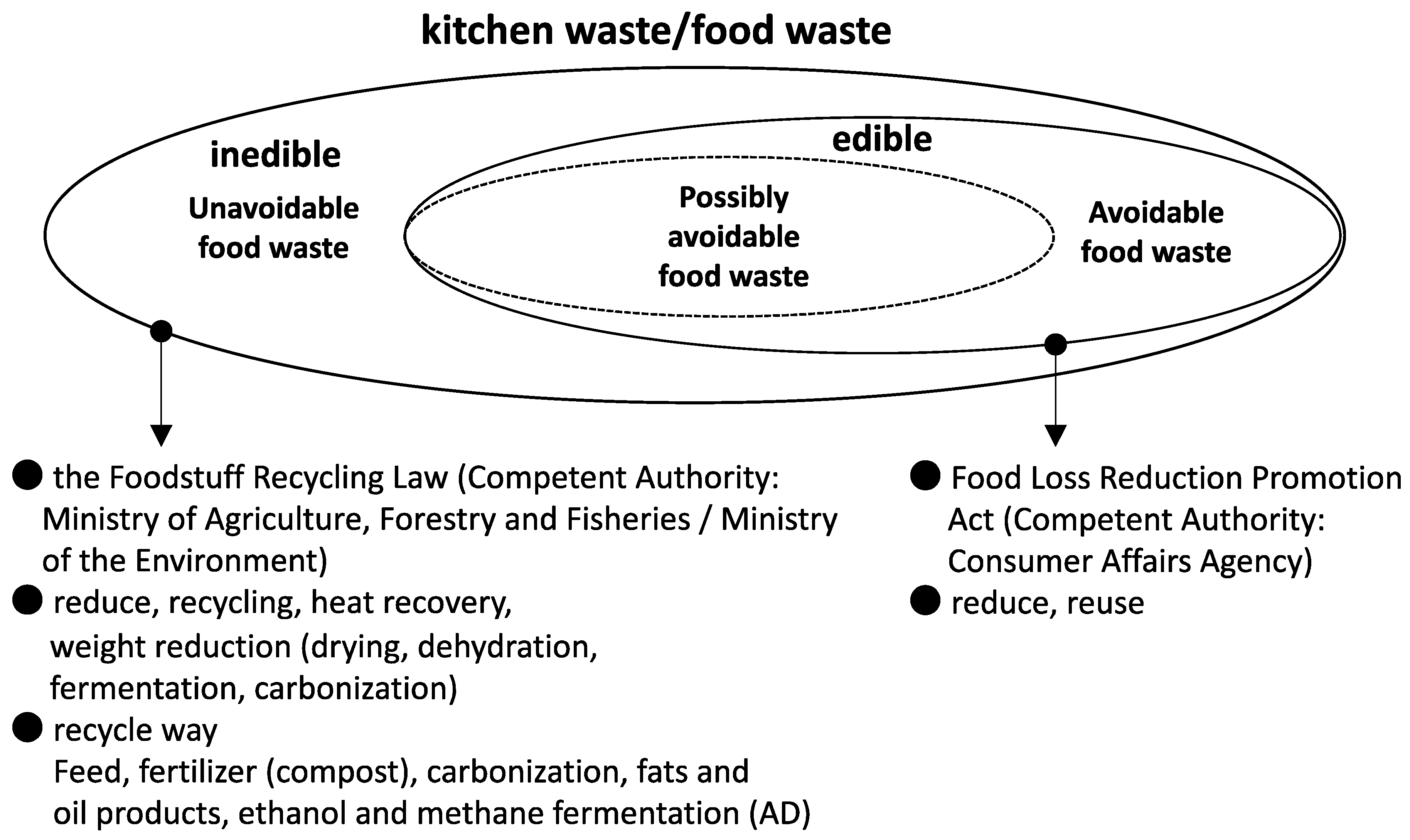
Figure 2.
Domestic production, imports, and supply for feed in Japan (source: food balance sheets).
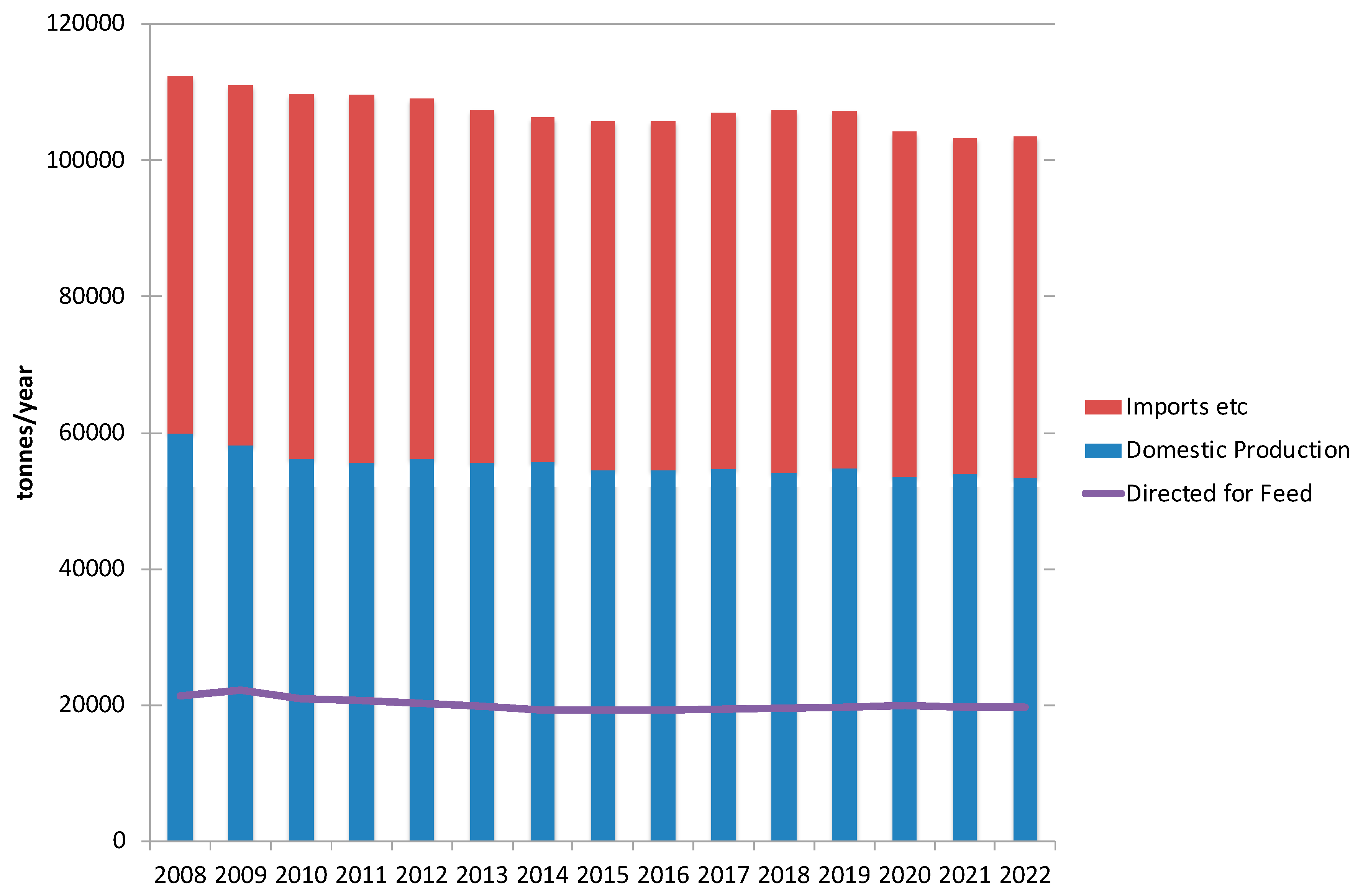
Figure 3.
Food Waste Generation by Sector [16].
Figure 3.
Food Waste Generation by Sector [16].
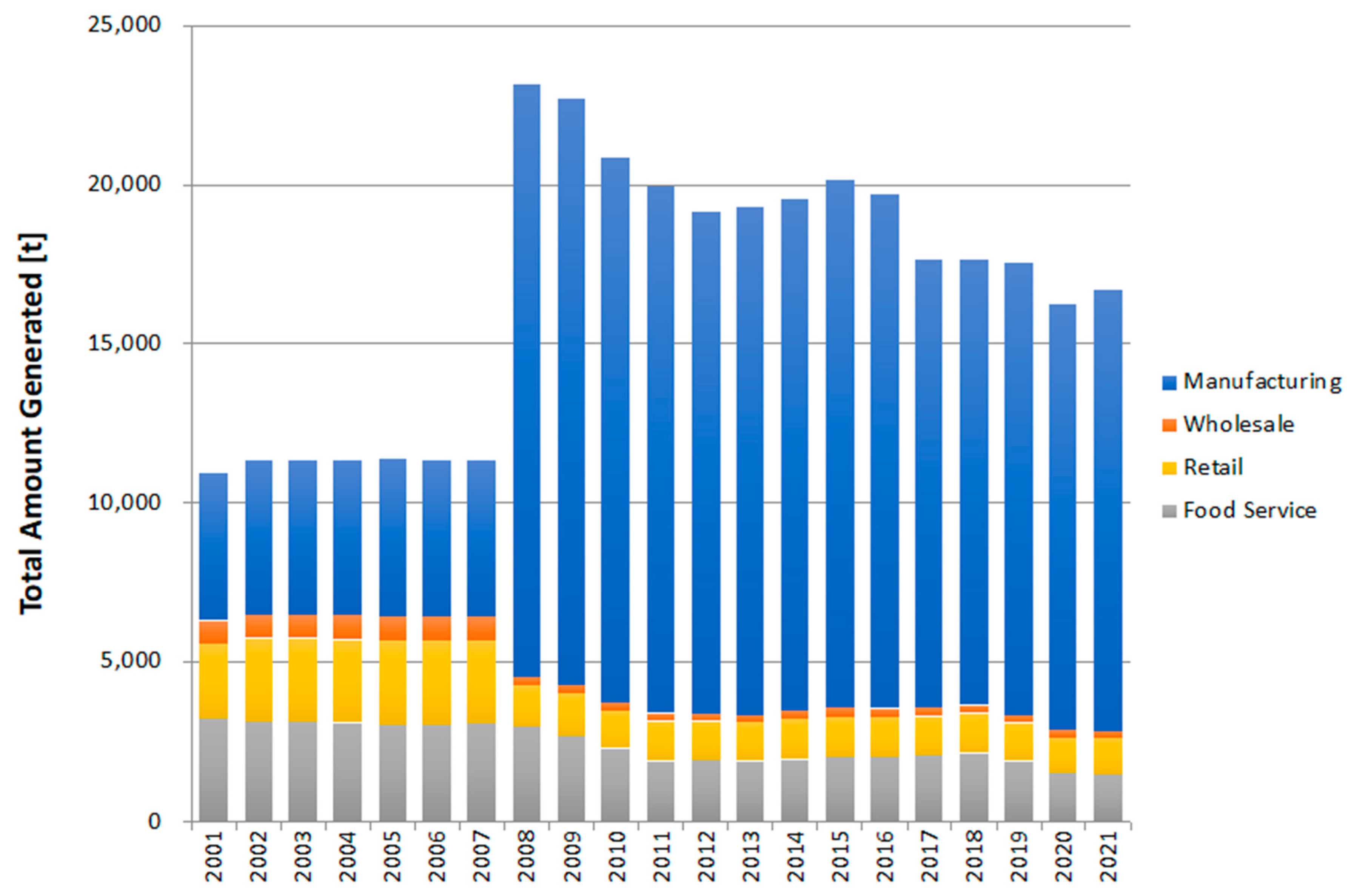
Figure 4.
Amount of food waste by industry, by recycling, and by avoidable food waste (2020) [17].
Figure 4.
Amount of food waste by industry, by recycling, and by avoidable food waste (2020) [17].
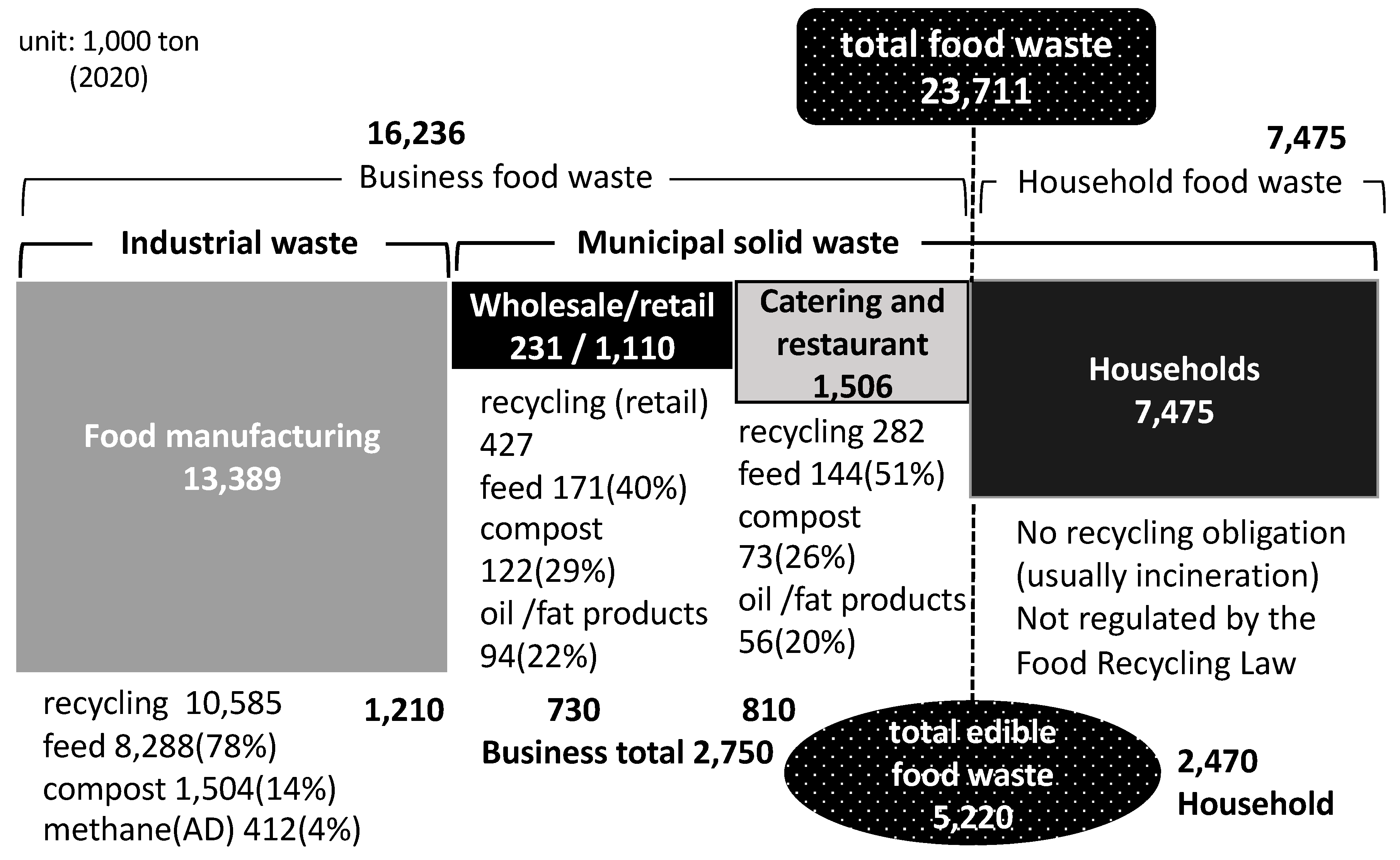
Figure 5.
Amount of food waste by type of recycling.
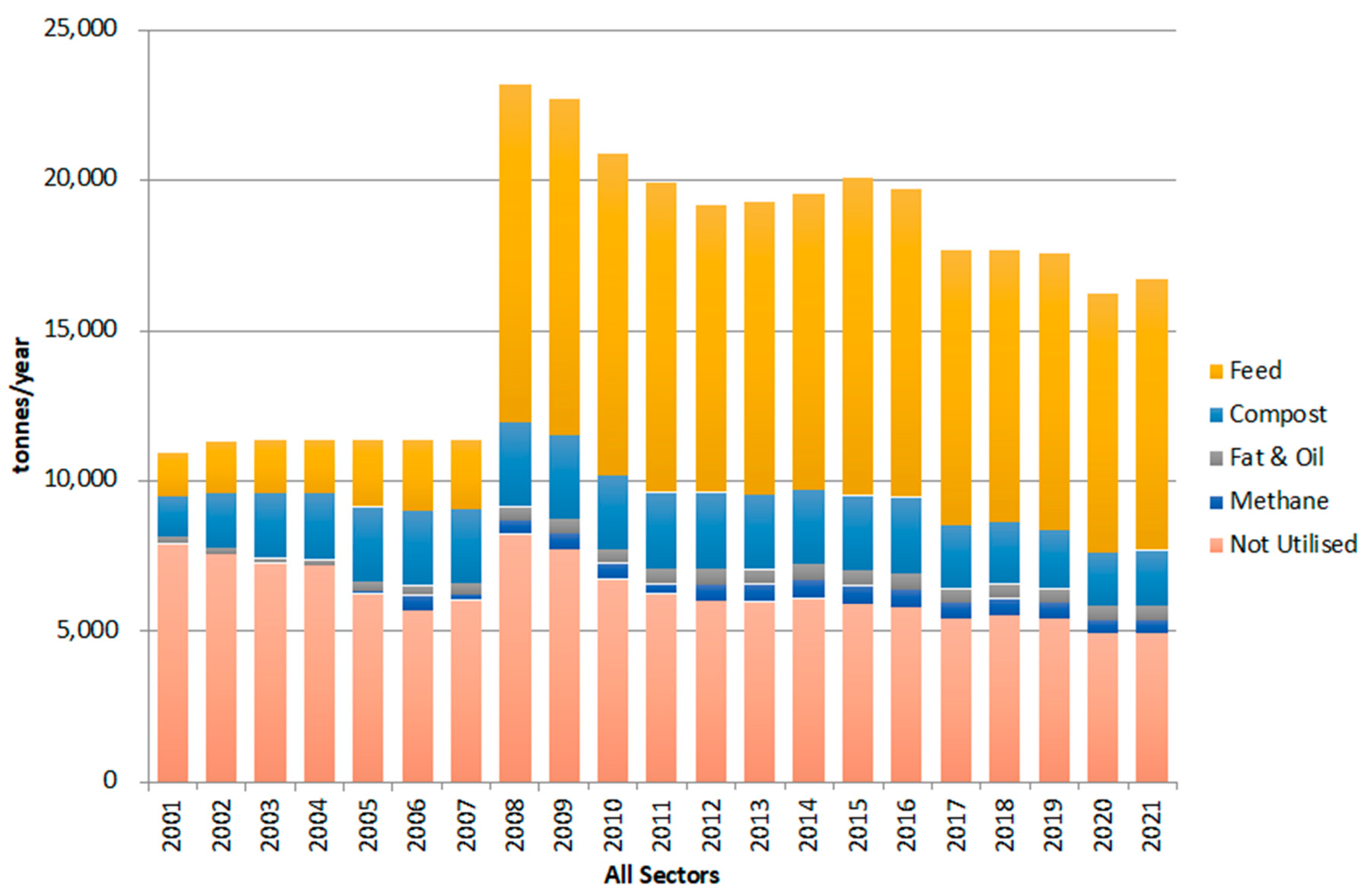
Figure 6.
Amount of Food Waste in Food Manufacturing by Type of Recycling.
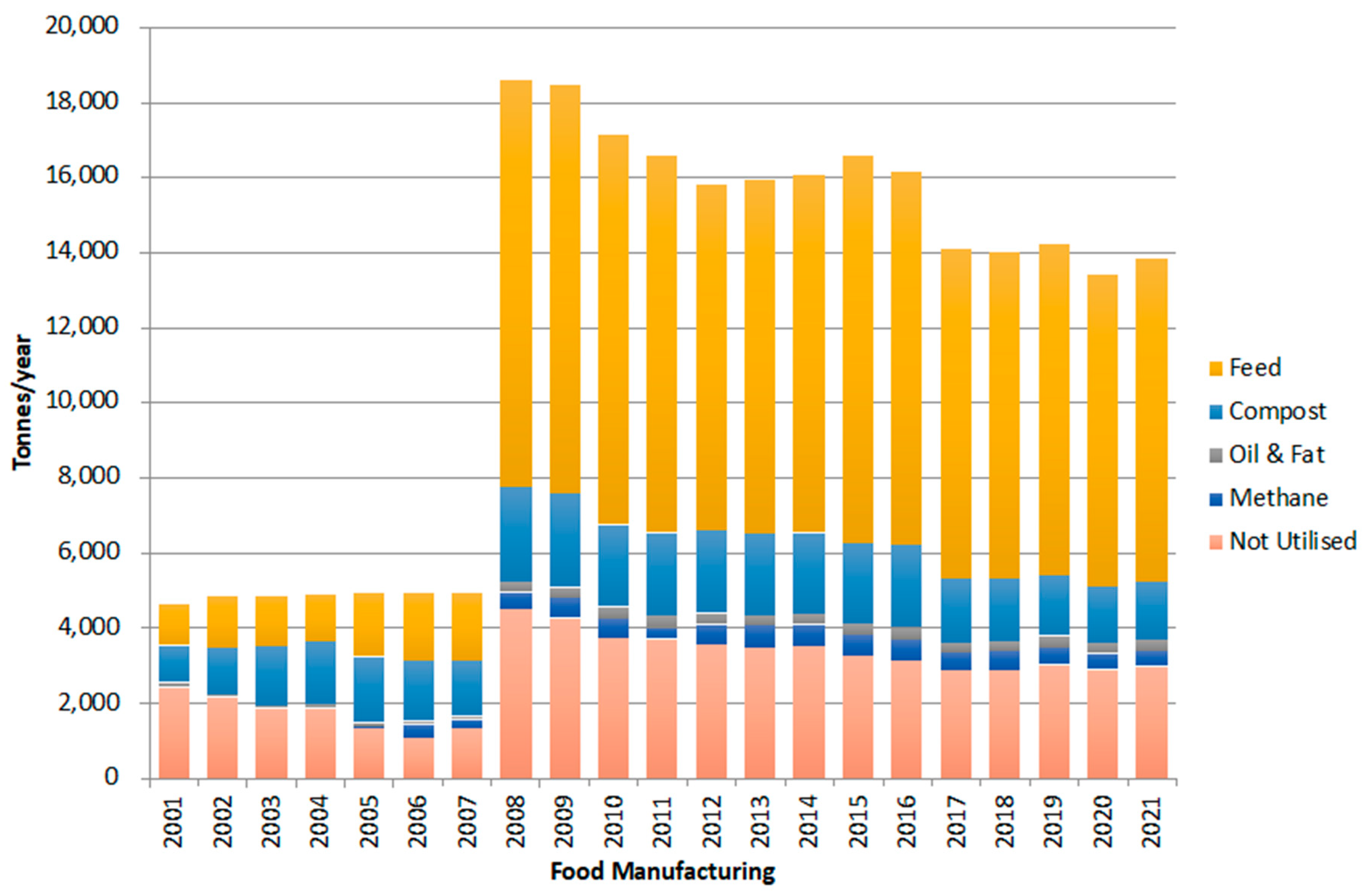
Figure 7.
Amount of Feed Recycling by Sector.
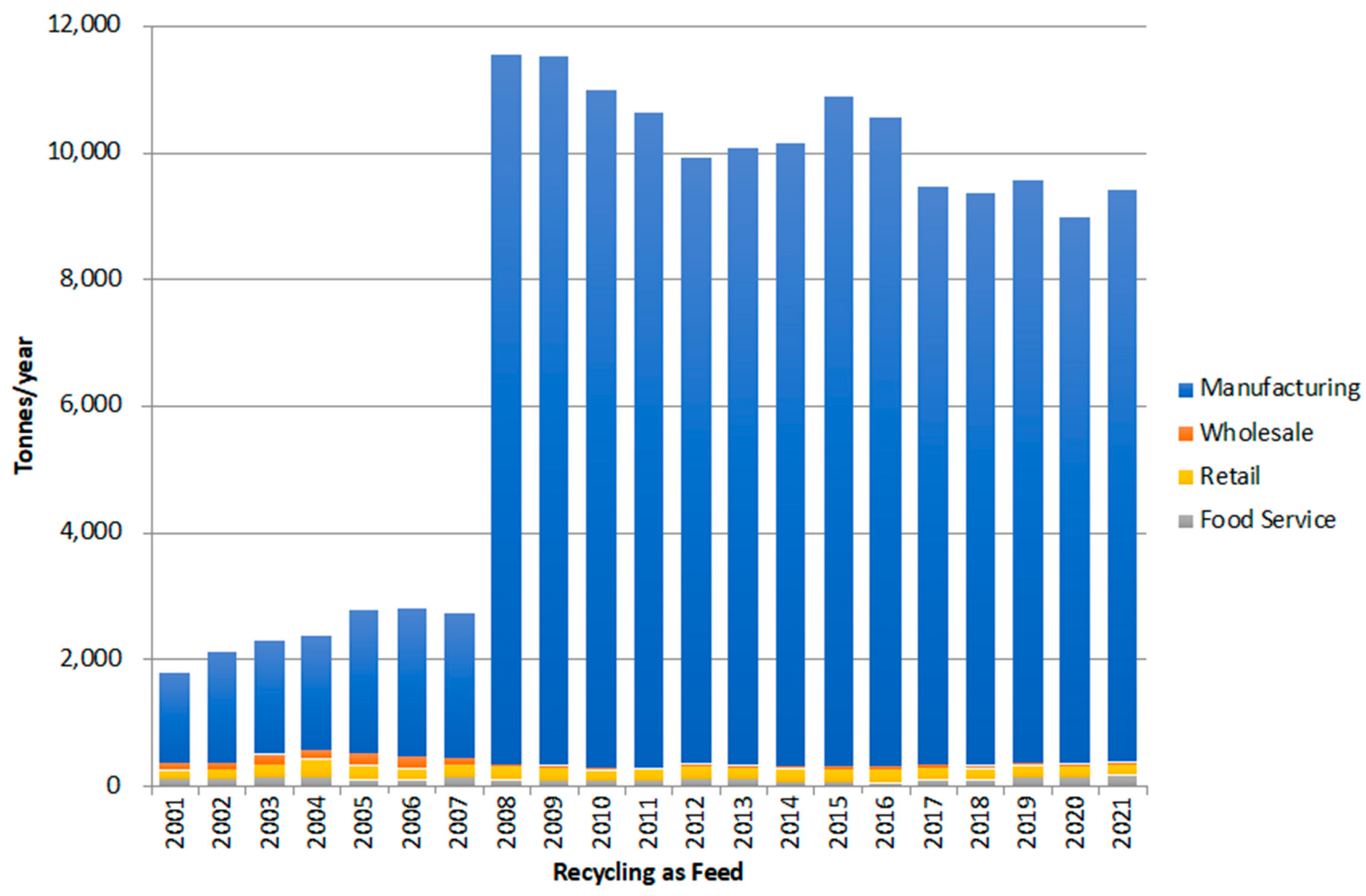
Figure 8.
Amount of Food Waste in Food Manufacturing by Type of Recycling.
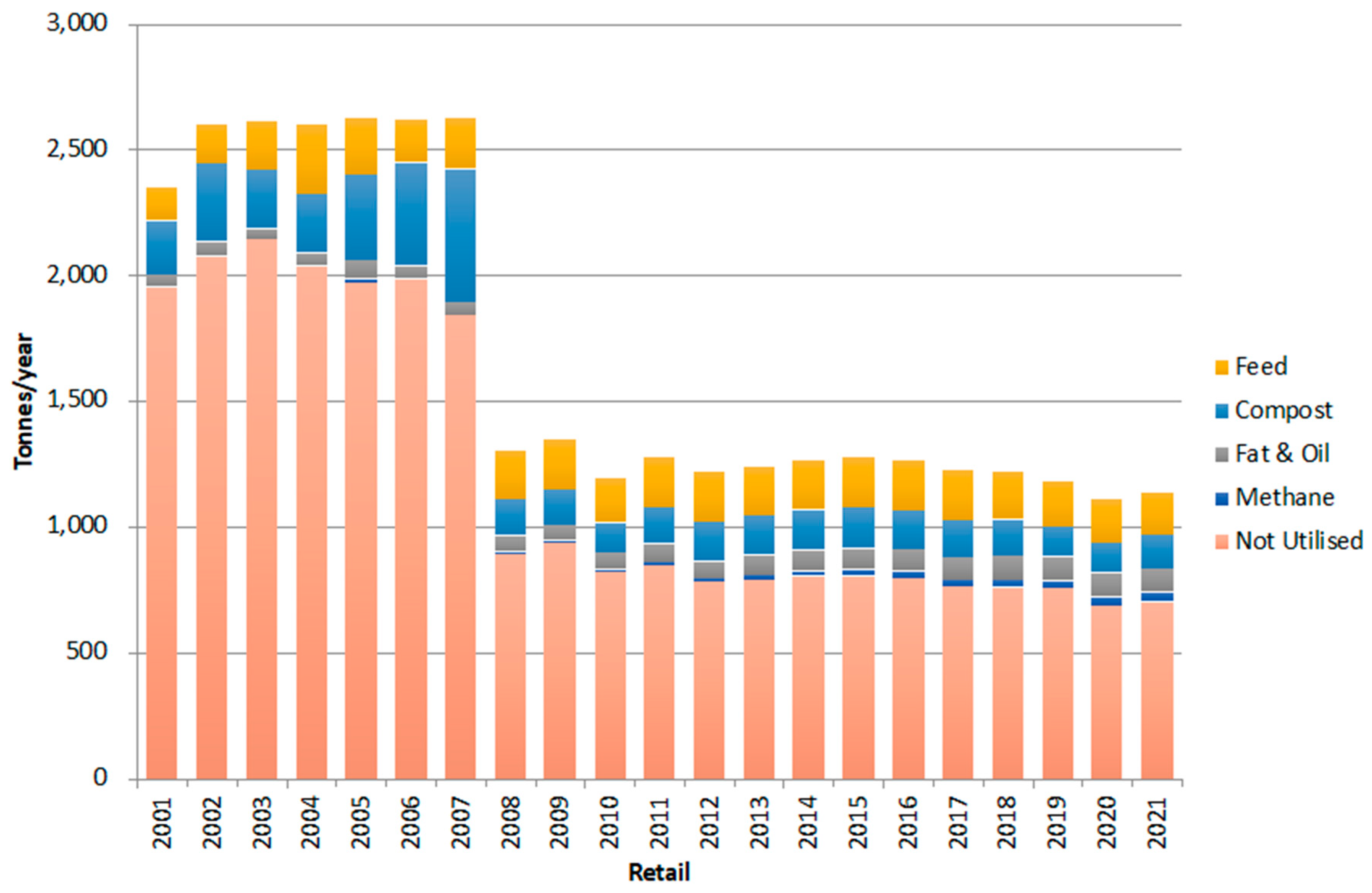
Figure 9.
Amount of Food Waste in Food Service by Type of Recycling.
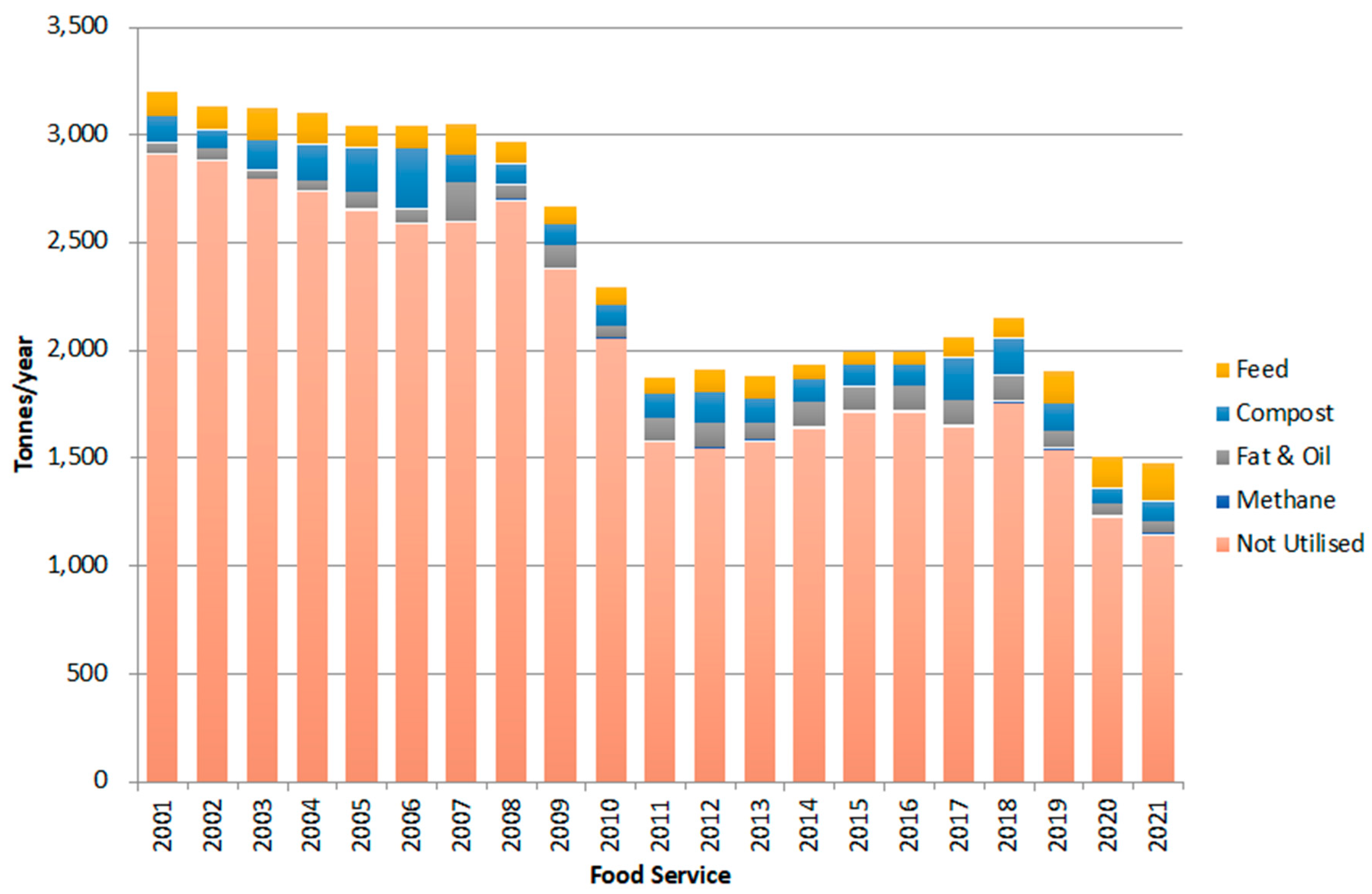
Figure 10.
Amount Composted by Sector.
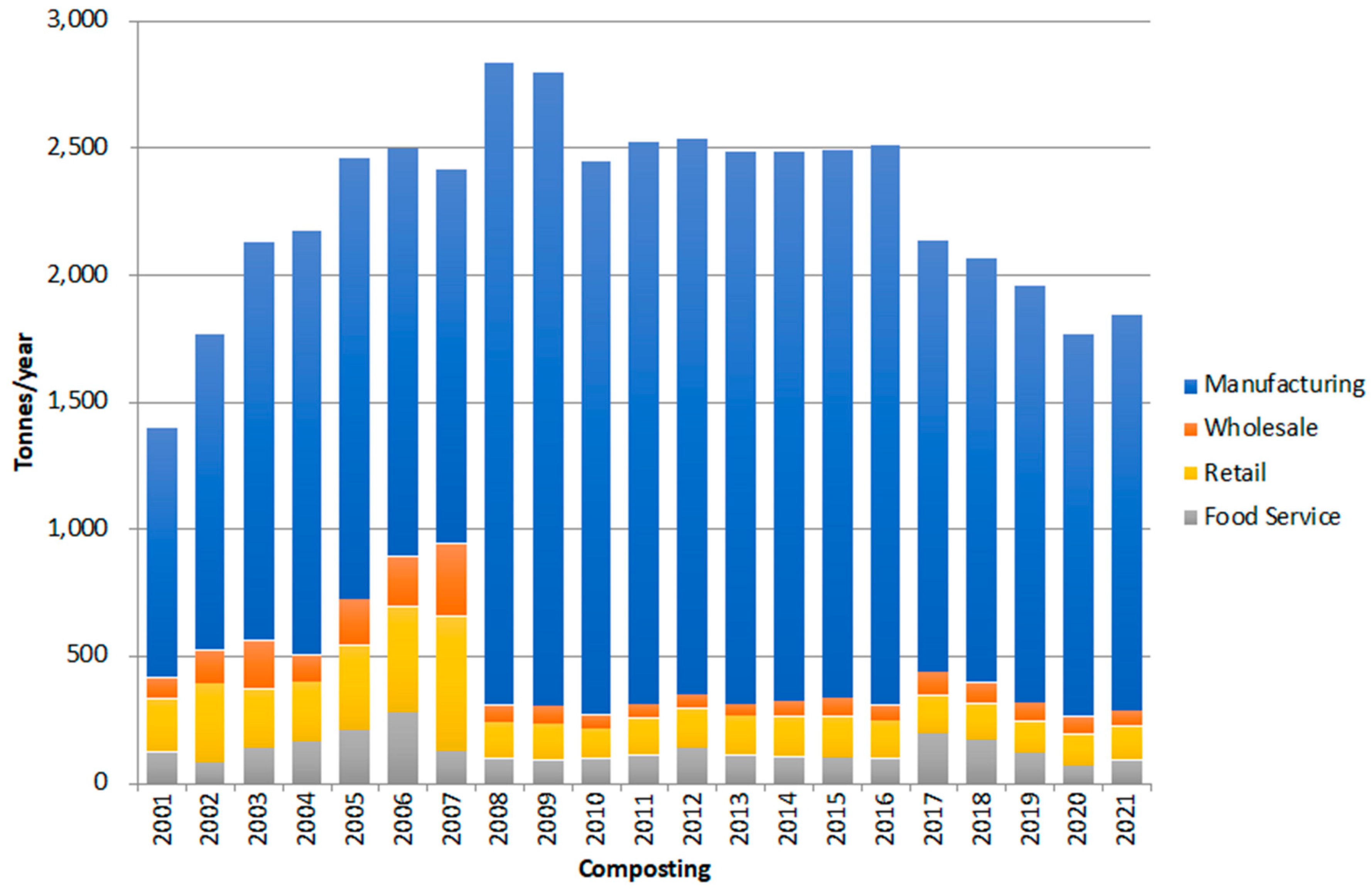
Figure 11.
Amount Directed to Methane Recovery by Sector.
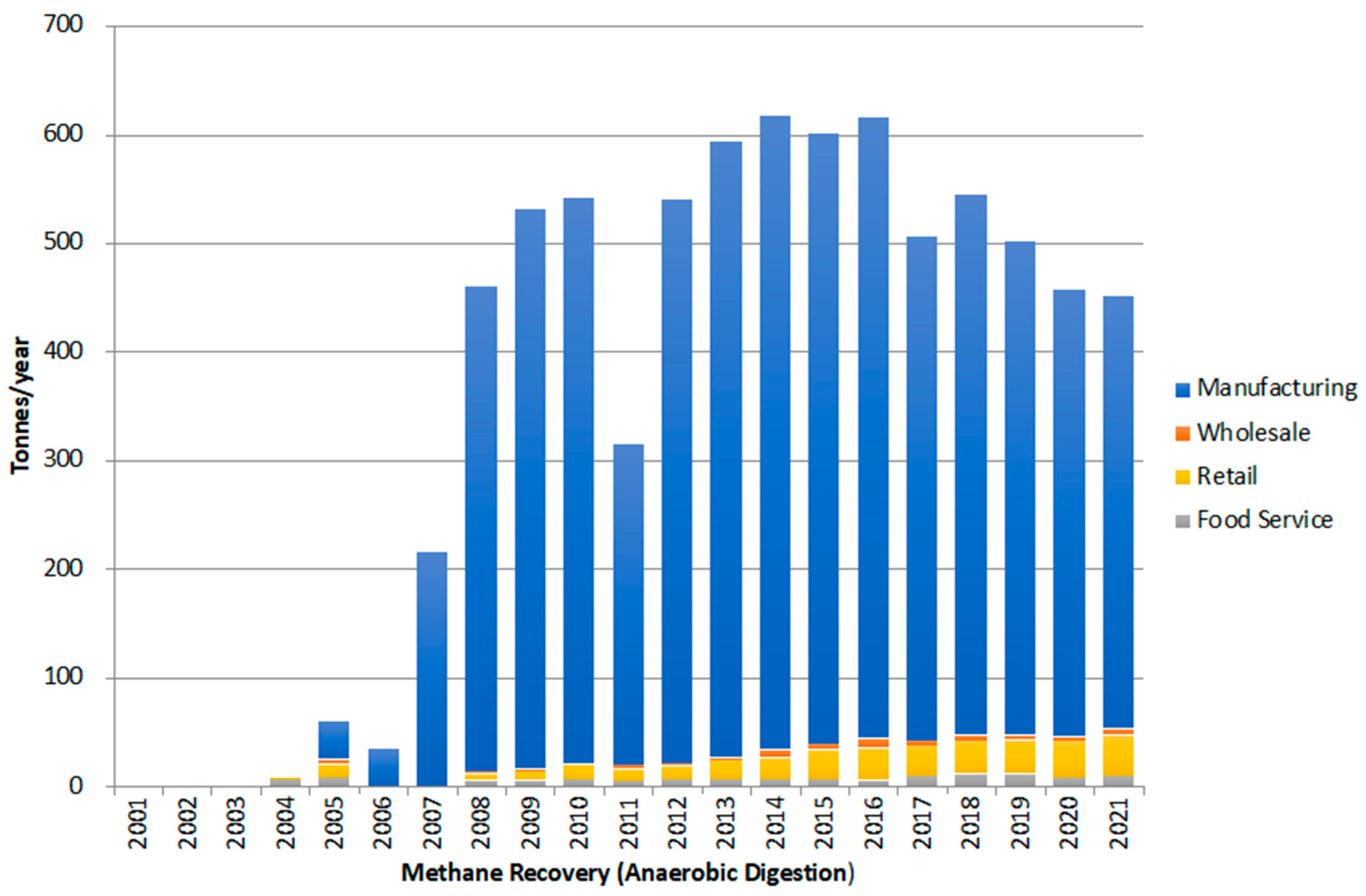
Figure 12.
Fat & Oil Recovery by Sector.
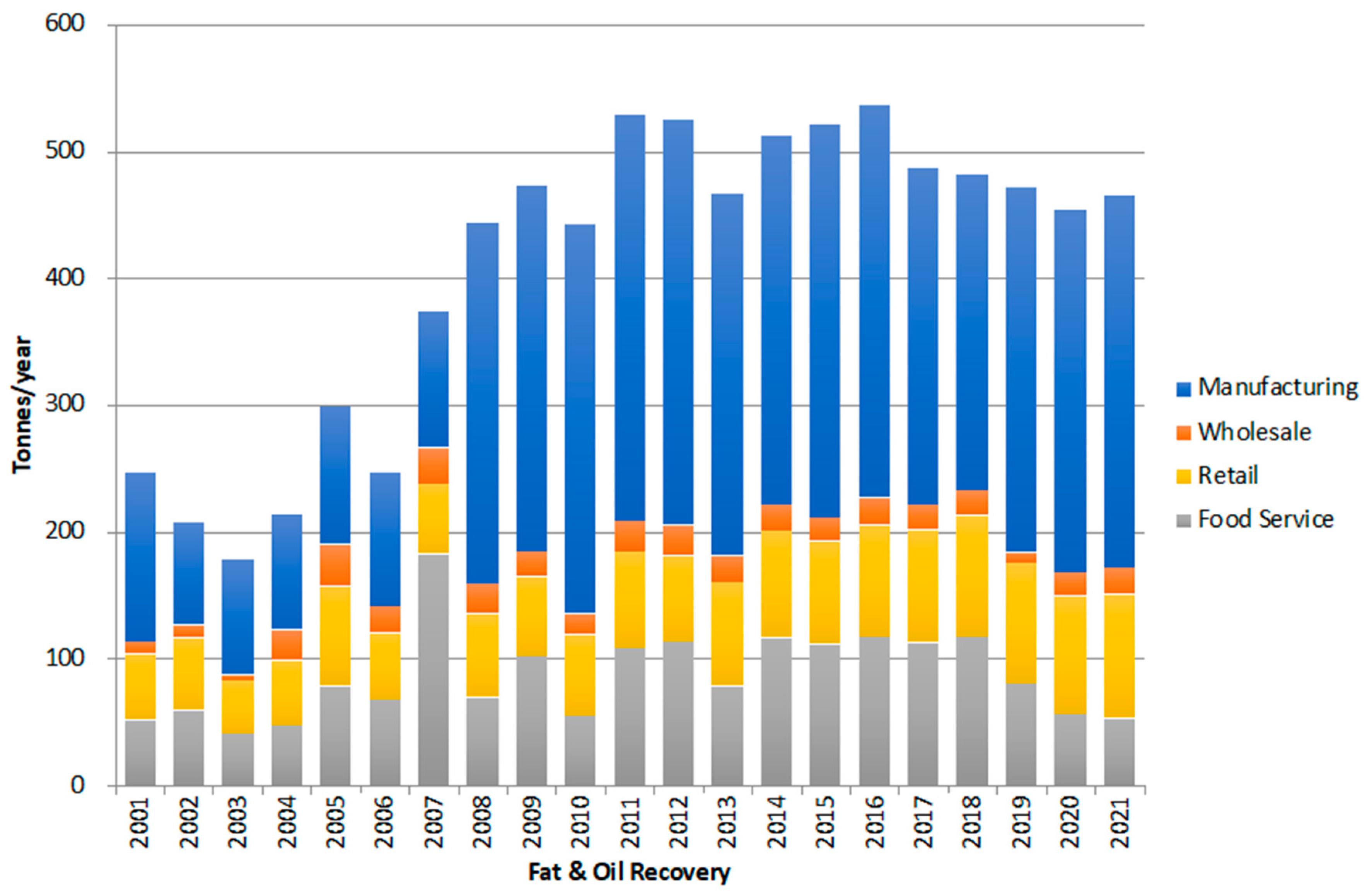
Figure 13.
Avoidable Food Waste by Household and Business Sectors.
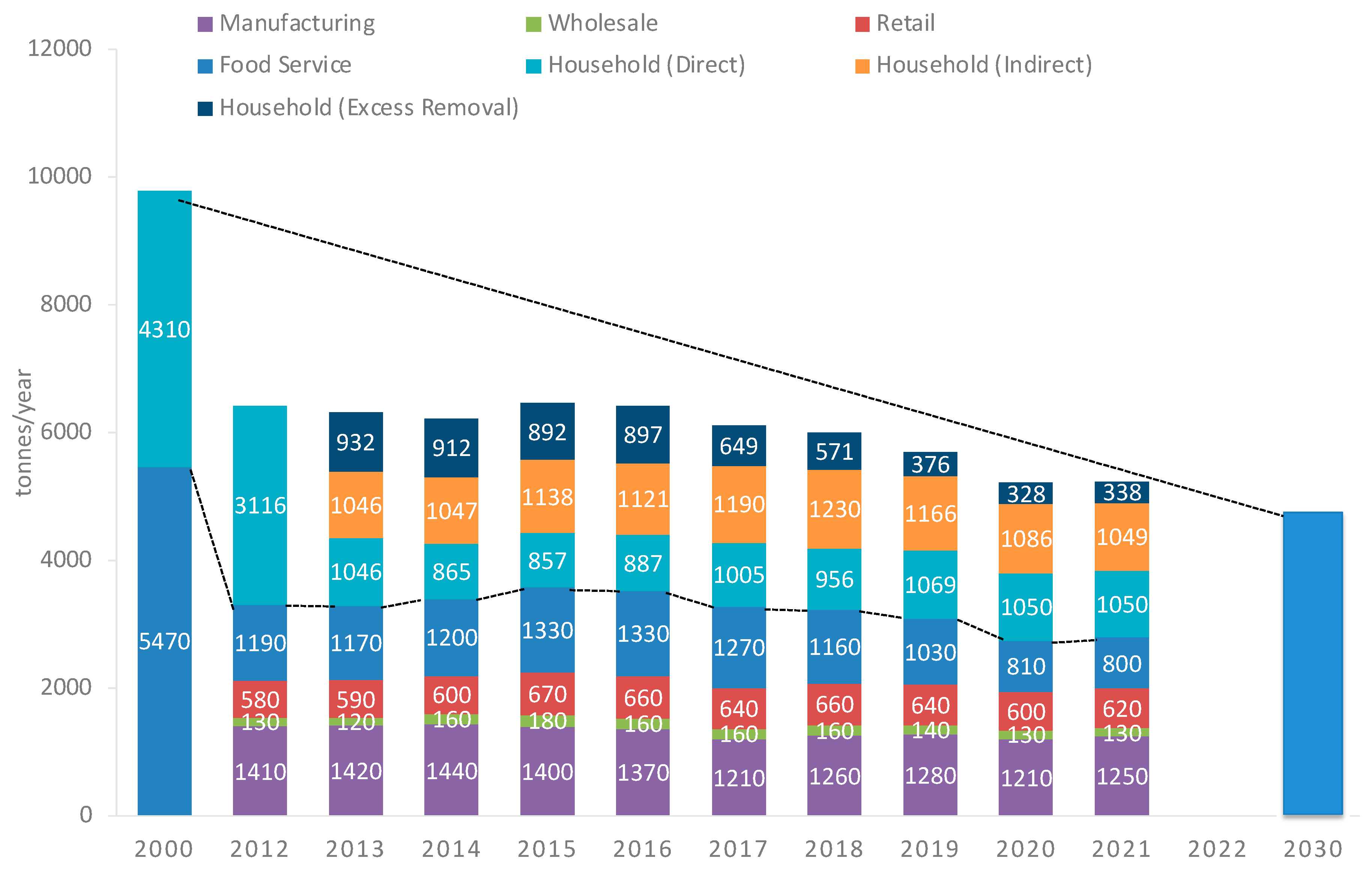
Disclaimer/Publisher’s Note: The statements, opinions and data contained in all publications are solely those of the individual author(s) and contributor(s) and not of MDPI and/or the editor(s). MDPI and/or the editor(s) disclaim responsibility for any injury to people or property resulting from any ideas, methods, instructions or products referred to in the content. |
© 2024 by the authors. Licensee MDPI, Basel, Switzerland. This article is an open access article distributed under the terms and conditions of the Creative Commons Attribution (CC BY) license (https://creativecommons.org/licenses/by/4.0/).
Copyright: This open access article is published under a Creative Commons CC BY 4.0 license, which permit the free download, distribution, and reuse, provided that the author and preprint are cited in any reuse.
MDPI Initiatives
Important Links
© 2024 MDPI (Basel, Switzerland) unless otherwise stated




